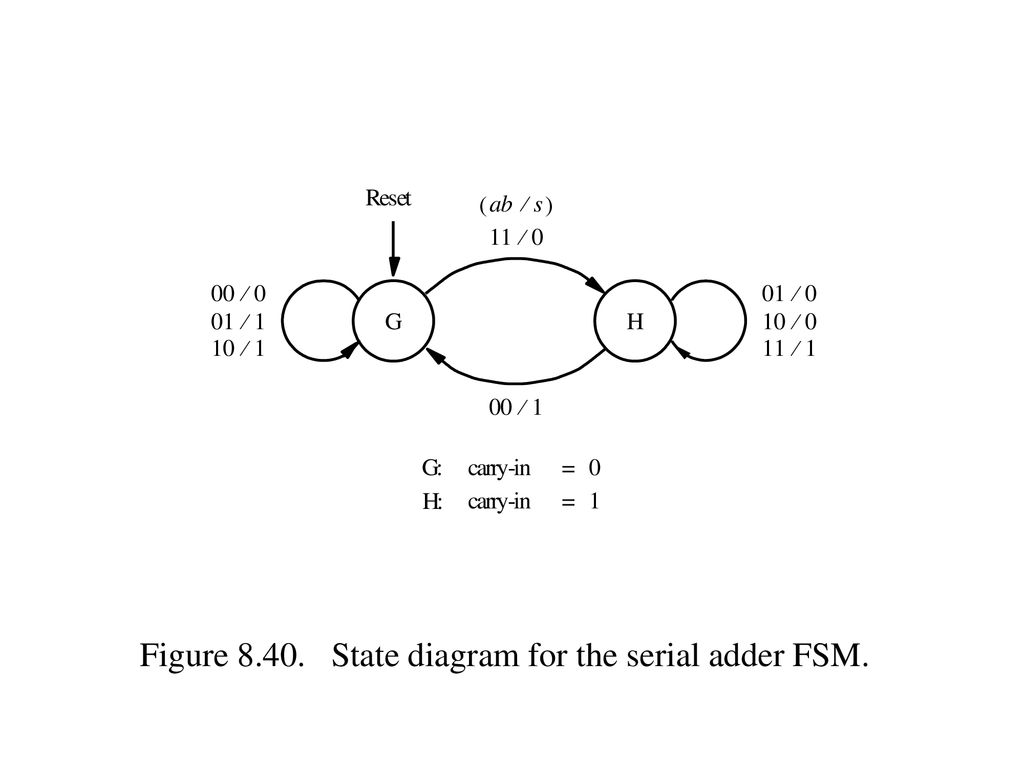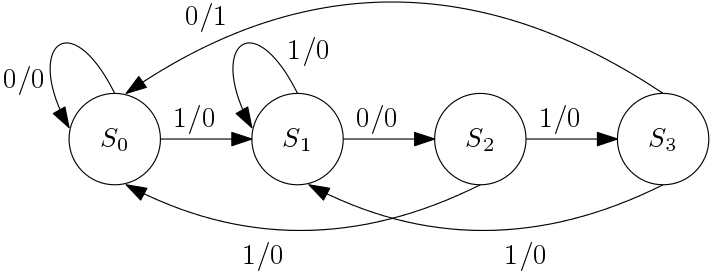Finite state machines — FPGA designs with VHDL documentation. Finite state machines ¶. In previous chapters, we saw various examples of the combinational circuits and sequential circuits. In combinational circuits, the output depends on the current values of inputs only; whereas in sequential circuits, the output. Verilog code for serial adder fsm using modelsim to simulate logic circuits in verilog designs. Eecs150 finite state machines in verilog. Piso verilog scribd. Verilog full adder example reference designer. Finite state machine fsm coding in vhdl vlsi encyclopedia. Finite state machine design and vhdl coding techniques. Free download here.
- Vhdl Code For Serial Adder Using Finite State Machine Programming
- Vhdl Code For Serial Adder Using Finite State Machines
- Vhdl Code For Serial Adder Using Finite State Machine Calculator
This page consists of design examples for state machines in VHDL. A state machine is a sequential circuit that advances through a number of states. The examples provide the HDL codes to implement the following types of state machines:
- 4-State Mealy State Machine
The outputs of a Mealy state machine depend on both the inputs and the current state. When the inputs change, the outputs are updated without waiting for a clock edge.
- 4-State Moore State Machine
The outputs of a Moore state machine depend only on the present state. The outputs are written only when the state changes (on the clock edge).
- Safe State Machine
This example uses the syn_encoding synthesis attribute value safe to specify that the software should insert extra logic to detect an illegal state and force the state machine's transition to the reset state.
- User-Encoded State Machine
This example uses the syn_encoding synthesis attribute to apply specific binary encodings to the elements of an enumerated type.
Download the files used in this example:

Each zip download includes the VHDL file for the state machine and its top level block diagram.
Related Links
Design Examples Disclaimer
These design examples may only be used within Intel devices and remain the property of Intel Corporation. They are being provided on an “as-is” basis and as an accommodation; therefore, all warranties, representations, or guarantees of any kind (whether express, implied, or statutory) including, without limitation, warranties of merchantability, non-infringement, or fitness for a particular purpose, are specifically disclaimed. Intel expressly does not recommend, suggest, or require that these examples be used in combination with any other product not provided by Intel.
VHSIC [Very High Speed Integrated Circuits] Hardware Description Language
IEEE-1076
This is just a quick reference of some short VHDL code fragments. Above each code segment is a circuit which represents the fragment.
In most cases the Process, and end of Process commands are not listed to keep the text down.
VHDL code for a D Flip Flop

process (signal names)
begin
if (clock’event and clock = ‘1’) then
output <= data;
end if;
end process
A 1 bit flip flop is used as the example. but any data width may be used.
Reference; a D Flip Flop Definition and true table.
VHDL code for a D Flip Flop with Reset and Clear

if reset = ‘0’ then
output <= ‘0’;
elsif set = ‘0’ then
output <= ‘1’;
elsif (clock’event and clock = ‘1’) then
output <= data;
end if;
Note that the code show asynchronous Reset and Clear lines, which is fine for the code segment.
However those lines should be synchronized at some point, or insure that no data is used when those lines are valid.
VHDL code for a D Flip Flop
if (clock’event and clock = ‘0’) then
if (reset = ‘0’ and data = ‘0’) then
output <= ‘0’;
elsif (reset = ‘0’ and data = ‘1’) then
output <= ‘0’;
elsif (reset = ‘1’ and data = ‘0’) then
output <= ‘0’;
elsif (reset = ‘1’ and data = ‘1’) then
output <= ‘1’;
end if;
Another flip flop using a reset, but this time just to zero out the data, as in a gating signal.
Again, the rest signal should have been synchronized with the clock at some point [in another code fragment].
VHDL code for a JK Flip Flop
if (clock’event and clock = ‘1’) then
if (in1 = ‘0’ and in2 = ‘0’) then
output <= output;
elsif (in1 = ‘1’ and in2 = ‘0’) then
output <= ‘1’;
elsif (in1 = ‘0’ and in2 = ‘1’) then
output <= ‘0’;
elsif (in1 = ‘1’ and in2 = ‘1’) then
output <= not(output);
end if;
end if;

Reference; a JK Flip Flop Definition and true table.
VHDL code for a 2-to-1 Mux
if sel = ‘0’ then
output <= data1;
elsif sel = ‘1’ then
output <= data2;
end if;
Reference Standard Logic Multiplexer Circuits.
This circuit may be scaled to any data width, and more complicated select functions can be implemented.
VHDL code for a Serial to Parallel Converter
if clear = ‘0’ then
shift_reg <= “00000000”;
elsif (clock’event and clock = ‘1’) then
shift_reg(7 downto 1) <= (6 downto 0);
shift_reg(0) <= serial;
end if;
A common 8 bit data path is coded as an example.
Reference Common Shift Register Functions.
VHDL code for a Parallel to Serial Converter
if load = ‘0’ then
shift_reg <= parallel;
elsif (clock’event and clock = ‘1’) then
serial <= shift_reg(7);
shift_reg(7 downto 1) <= (6 downto 0);
end if;
A common 8 bit data path is coded as an example.
Reference Common Shift Register Functions.
VHDL code for a 4 bit Counter
if load = ‘0’ then
output <= “1111”;
elsif (clock’event and clock = ‘1’) then
output <= data - ‘1’;
end if;
carry <= ‘0’ when output = “0000” else‘1’;
load <= carry;
The code provides a 4 bit down counter function.
Reference common logic functions; Up/Down Decade Counters, or Up/Down Binary Counters.
VHDL code for a 1 bit Adder
if c = ‘0’ then
if (a and b) = ‘1’ then
sum <= ‘0’;
carry <= ‘1’;
elsif (a or b) = ‘1’ then
sum <= ‘1’;
carry <= ‘0’
end if;
elsif c = ‘1’ then
if (a and b) = ‘1’ then
sum <= ‘1’;
carry <= ‘1’;
elsif (a or b) = ‘1’ then
sum <= ‘0’;
carry <= ‘1’;
end if;
end if;
An adder could be a half adder which does not accept a carry in or a full adders that uses a carry input [as shown].
It's assumed that these inputs are some how synchronized with a clock.
Reference; Types of IC Adders, with logic diagram.
VHDL code for a State Machine
if reset = ‘0’ then
state <= stateA;
output <= ‘0’;
elsif (clock’event and clock) = ‘1’ then
case state is
when stateA
output <= ‘0’;
state <= stateB
when stateB
output <= ‘1’;
if input = ‘1’ then
state <= stateB;
else
state <=stateC;
end if;
when stateC
output <= ‘0’
state <= stateA;
end case;
Exclusive-OR Gate
Vhdl Code For Serial Adder Using Finite State Machine Programming
if (a and b) = ‘1’ then
y <= ‘0’;
elsif (a and b) = ‘0’ then
y <= ‘0’;
else
y <= ‘1’;
end if;
Reference; a Exclusive-OR Gate Definition and true table.
IEEE-1076: Standard VHDL Language Reference Manual IEEE Computer Society Document
IEEE 1076.1: VHDL Analog and Mixed-Signal Extensions IEEE Computer Society Document
IEEE 1076.2: Standard VHDL Mathematical Packages IEEE Computer Society Document
IEEE 1076.3: Standard VHDL Synthesis Packages IEEE Computer Society Document
IEEE 1076.4: Standard for VITAL ASIC (Application Specific Integrated Circuit) Modeling Specification IEEE Computer Society Document
IEEE 1076.6: Standard for VHDL Register Transfer Level (RTL) Synthesis IEEE Computer Society Document
Links on this site:
VHDL Sites: Listed here
Back to the Logic Design Page, Digital Logic Pitfalls
VHDL Design Tools: CAD - CAE Products
VHDL Simulation Tools: VHDL Simulation Software Products
FPGA Manufactures: Hardware - Components - Semiconductor- Digital - Programmable Logic
Vhdl Code For Serial Adder Using Finite State Machines
In regards to flip-flops and other examples, there are no constraints on using standard functions.
That is a flip flop does not have to be constrained to a D-type or JK-type function, any number of commands might be used.
The functions provided do relate to an available IC function so comparisons can be made between the firmware and hardware.
| Home | |||||||
| Distributors | Components | Equipment | Software | Standards | Buses | Design | Reference |
Vhdl Code For Serial Adder Using Finite State Machine Calculator
© 1998 - 2016 All rights reserved Larry Davis